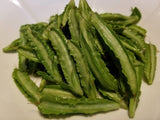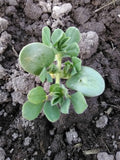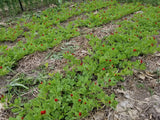Asparagus Pea
(Lotus tetragonolobus); aka Winged Pea; Prostrate bush; Edible pod; Minimum 3.4 cc (>30 seeds)
We fell in love with winged beans when we lived in China. Unfortunately, since the Asian winged bean varieties are daylight sensitive, they do not produce well in northern gardens. Seeking a suitable substitute, we happily discovered asparagus peas.
A plant that thrives in poor soil, asparagus peas trace their origins to north Africa and Mediterranean Europe. While records suggest they were cultivated in Sicily since the mid-16th century, their introduction to gardeners is credited to English botanist Phillip Miller in 1734.
Unlike climbing winged beans, asparagus peas grow in branches that spread laterally (up to 24 inches) from a central point to form a low-growing canopy that stands about 6 inches tall. Gorgeous red blossoms adorn branch edges in pairs and give way to the unique, frilly-edged, four-lobed edible pods. Highly ornamental, they fit easily into landscaping that prohibits vegetables.
First producing at roughly 60 days, we enjoy the whole green pods steamed or sautéed. We find they are best under 2 inches long but older, larger pods are also good when prepared and eaten as one does edamame. Though we've not yet prepared them such, pods are also good batter fried and pickled. The dry seeds, though small, are usable in dry bean recipes.
Without doubt, my patch of asparagus peas with their gorgeous blooms and whimsical pods is one of my favorite parts of the gardens...
Direct seed when soil temperature is consistently above 70°F. Soak seeds overnight before sowing.
For seed saving, simply allow pods to dry on the plant. I let the plant remain in the ground until first hard frost and then lift if whole to hang in a warm, dry location until ready to process. Seeds thresh fairly easy from the pods when they are thoroughly dry. Unless you grow another variety in the Lotus tetragonolobus botanical group, the seeds harvested will be true-to-type.











